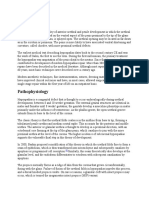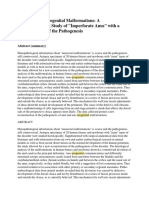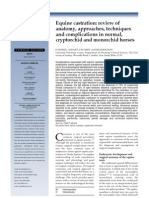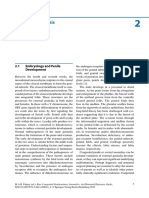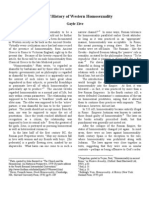EMBRYOLOGY - The External Genitalia in The Two Sexes Develop From Common Anlagen (Genital Tubercle
EMBRYOLOGY - The External Genitalia in The Two Sexes Develop From Common Anlagen (Genital Tubercle
Uploaded by
Leni LukmanCopyright:
Available Formats
EMBRYOLOGY - The External Genitalia in The Two Sexes Develop From Common Anlagen (Genital Tubercle
EMBRYOLOGY - The External Genitalia in The Two Sexes Develop From Common Anlagen (Genital Tubercle
Uploaded by
Leni LukmanOriginal Description:
Original Title
Copyright
Available Formats
Share this document
Did you find this document useful?
Is this content inappropriate?
Copyright:
Available Formats
EMBRYOLOGY - The External Genitalia in The Two Sexes Develop From Common Anlagen (Genital Tubercle
EMBRYOLOGY - The External Genitalia in The Two Sexes Develop From Common Anlagen (Genital Tubercle
Uploaded by
Leni LukmanCopyright:
Available Formats
EMBRYOLOGY The external genitalia in the two sexes develop from common anlagen (genital tubercle,
swellings, and fold) and are indistinguishable up until seven to eight weeks gestation (figure 1).
At the ninth week of gestation, the external genitalia begin to differentiate between the two sexes.
In the male fetus, genetic programming results
in androgenic stimulation that induces posterior
fusion of the genital folds and growth of the
genital tubercle into a phallic structure (picture
2). The penile urethra forms as a result of
remolding and fusion of the medial edges of the
endodermal urethral folds [1]. By 12 weeks
gestation, the coronal sulcus separates the glans
from the shaft of the penis. By 16 to 18 weeks,
urethral formation is complete, and the foreskin
covers the glans.
In patients with hypospadias, the urethral folds
fail to completely or partial close. The extent of
the failure determines the position of the
urethral opening. In most cases, it remains
unknown what causes the disruption of normal
penile development.
Penile curvature occurs normally during
development and resolves by the end of urethral
formation (picture 2). In patients with
hypospadias, abnormal penile curvature (also
referred to as chordee) is often an associated
physical finding suggesting an accompanying
disruption in the development of the penile
shaft.
The lack of androgenic stimulation results in
the female external genital phenotype, although
additional data suggest that female development
is not a completely passive process.
ANATOMY Surgical correction of hypospadias requires understanding of the anatomy of both the normal
and hypospadiac penis [2].
The penis in the uncircumcised male consists of the penile shaft, glans penis with the coronal sulcus (rim of the
glans), and the foreskin (figure 2). The structural components include the corpus spongiosum, which contains
the urethra, and the paired corpora cavernosa. The corpus spongiosum lies ventral in between the two corporal
bodies. The corpora cavernosa structures are covered by the thick, elastic tunica albuginea. The dorsal penile
nerve lies within Buck's fascia, which circumferentially envelops the corpus spongiosum and cavernosa.
Sensation of the penile shaft, glans, and anterior urethra is primarily derived from the dorsal penile nerves. The
neurovascular bundles lie in the 11 and 1 o'clock position with branches extending longitudinally from 11 to 7
o'clock and 1 to 5 o'clock along the surface of the tunica albuginea, enclosing the corpora cavernosa, and
terminating in the glans. No nerve fibers are found at the 12 o'clock position in either the normal or hypospadiac
penis [3].
Classification The severity of hypospadias is graded upon the position of the urinary meatus and the extent
of ventral penile angulation. Severity rises as the distance of the displaced urethral opening increases from the
normal position at the tip of the glans, and with increasing penile curvature.
Historically, hypospadias was divided into three classes, as the distance of the displaced urethral opening
increases from the normal position at the tip of the glans.
First degree (mild) Urethral opening within
the glans or subcorona
Second degree (moderate) Urethral opening
on the penile shaft
Third degree (severe) Urethral opening
within the scrotum or perineum
However, this classification does not account for the effect of penile curvature (chordee). As an example,
patients with the abnormal urethral meatus at the glans or distal penile shaft who have severe chordee will
require extensive surgical correction to correct the curvature resulting in a more proximal hypospadiac urethral
opening.
PATHOGENESIS Disruption of the androgenic stimulation that is required for the development of the
normal male external genitalia is the proposed mechanism resulting in hypospadias [4,5]. Support for this theory
is based upon reports of patients with defects in genes that affect androgen metabolism, and estrogen and
androgen response (eg, androgen receptor) [6-14]. Genome-wide association studies using SNP (single
nucleotide peptide) microarrays have shown an association between variants of the gene DGKK located on the
X chromosome and hypospadias [15,16]. DGKK is expressed in preputial skin and encodes a human type II
diacylglycerol kinase, which plays an important role in signal transduction. Changes in the genes activating
transcription factor 3, CXorf6, and the zinc finger-box gene 1 have also been associated with an increased risk
of hypospadias [8,9,13].
Exposure to estrogenic compounds (eg, maternal progestin or diethylstilbestrol) during pregnancy, which may
affect androgenic stimulation, is also associated with hypospadias [17-19]. In contrast, a study using data from
the National Birth Defects Prevention study found that maternal high dietary intake of phytoestrogens (plant
constituents with estrogenic properties) was associated with a decreased risk of hypospadias [20]. The observed
associations merit investigation in additional populations before firm conclusions can be reached. (See"Outcome
and follow-up of diethylstilbestrol (DES) exposed individuals", section on 'Genitourinary abnormalities'.)
In most cases of hypospadias, however, the cause is unknown. Both genetic and environmental factors are
associated with hypospadias, suggesting that the etiology is multifactorial [17,19,21,22]. These include the
following:
Advanced maternal age
Preexisting maternal diabetes mellitus
Gestational age before 37 weeks
History of paternal hypospadias
Exposure to smoking and pesticides
You might also like
- 어바웃타임 한글영어 통합대본Document62 pages어바웃타임 한글영어 통합대본두루미No ratings yet
- MRKH Sundrome PPTDocument37 pagesMRKH Sundrome PPTleenarobin100% (2)
- Brave New World TestDocument5 pagesBrave New World TestFrancesco FalconeNo ratings yet
- Silverio Case Ateneo Law Journal PDFDocument23 pagesSilverio Case Ateneo Law Journal PDFEver AlcazarNo ratings yet
- Hypospadias: Laurence S. Baskin M.D., FAAPDocument20 pagesHypospadias: Laurence S. Baskin M.D., FAAPMerlin MuktialiNo ratings yet
- 2000 - Hypospadias. Anatomy, Embryology, andDocument9 pages2000 - Hypospadias. Anatomy, Embryology, andtiaraNo ratings yet
- Pediatric Urology PDFDocument14 pagesPediatric Urology PDFekalospratamaNo ratings yet
- Reference HipospadiaDocument14 pagesReference HipospadiaHasya KinasihNo ratings yet
- Review: Urogenital Sinus Malformation: From Development To ManagementDocument10 pagesReview: Urogenital Sinus Malformation: From Development To ManagementNatalia Bustamante ArangoNo ratings yet
- Rare Congenital Genitourinary AnomaliesDocument27 pagesRare Congenital Genitourinary Anomaliesد. محمد عبد الباقي فهميNo ratings yet
- HipospadiDocument12 pagesHipospadiArtrinda AnggitaNo ratings yet
- Imperforate Anus and Cloacal MalformationsDocument110 pagesImperforate Anus and Cloacal MalformationsAhmad Abu KushNo ratings yet
- Pediatric UrologyDocument14 pagesPediatric UrologycibunNo ratings yet
- True Undescened TestesDocument42 pagesTrue Undescened TestesSahirNo ratings yet
- HypopediasisDocument8 pagesHypopediasisv_vijayakanth7656No ratings yet
- Pediatric Urology UnlockedDocument15 pagesPediatric Urology UnlockedPine's FauNo ratings yet
- Continuing Education Activity: HypospadiasDocument6 pagesContinuing Education Activity: HypospadiasMaulani Nurlatifah100% (1)
- HipospadiaDocument66 pagesHipospadiaDichaNo ratings yet
- Sample Chapter HypospadiasDocument22 pagesSample Chapter HypospadiasJamalNo ratings yet
- CriptorchidsmDocument9 pagesCriptorchidsmemirilejlaNo ratings yet
- Opening 1.1 BackgroundDocument17 pagesOpening 1.1 Backgroundvictor zhefaNo ratings yet
- KriptorkismusDocument14 pagesKriptorkismusMutiara Prima DianaNo ratings yet
- Anal and Ano-Urogenital Malformations: A Histopathological Study of "Imperforate Anus" With A Reconstruction of The PathogenesisDocument7 pagesAnal and Ano-Urogenital Malformations: A Histopathological Study of "Imperforate Anus" With A Reconstruction of The PathogenesisTuti DamNo ratings yet
- Hernia AnakDocument31 pagesHernia AnakHerry SukmawardiNo ratings yet
- Pediatric HerniasDocument19 pagesPediatric HerniasAndria SaputraNo ratings yet
- 3 - Anatomy, Abdomen and Pelvis - Female Internal Genitals - StatPearls - NCBI BookshelfDocument10 pages3 - Anatomy, Abdomen and Pelvis - Female Internal Genitals - StatPearls - NCBI BookshelfmimatechcontabilidadNo ratings yet
- Undescended TestisDocument66 pagesUndescended TestisalaaNo ratings yet
- Benign Cervical Lesions and Congenital Anomalies of The Cervix - UpToDateDocument33 pagesBenign Cervical Lesions and Congenital Anomalies of The Cervix - UpToDatecriswesi23No ratings yet
- Case Study AFPMedCen Crypt Orchid IsmDocument14 pagesCase Study AFPMedCen Crypt Orchid Isme25g60No ratings yet
- MRKH SundromeDocument37 pagesMRKH SundromeBudi Iman SantosoNo ratings yet
- HirschprungDocument6 pagesHirschprungVanessa CasingalNo ratings yet
- Undescended Testes (Orchidopexy)Document9 pagesUndescended Testes (Orchidopexy)nuranysha havizNo ratings yet
- ArticleDocument8 pagesArticledrhamissouNo ratings yet
- Exstrophy and Epispadias MedscapeDocument18 pagesExstrophy and Epispadias MedscapeMohammad Rifqi WibowoNo ratings yet
- Bladder ExstrophyDocument37 pagesBladder Exstrophymohamademil1983No ratings yet
- Hirschsprung Disease: Historical NotesDocument17 pagesHirschsprung Disease: Historical Notesdesthalia cyatraningtyasNo ratings yet
- Research Penis EnlargementDocument10 pagesResearch Penis Enlargementalan100% (1)
- Standard Klasifikasi HipospadiaDocument5 pagesStandard Klasifikasi HipospadiaEzi SeptyandraNo ratings yet
- Equine Castration AU Vet JournalDocument7 pagesEquine Castration AU Vet JournalYolandi Lewis StoltzNo ratings yet
- Regulation Testicular DescendDocument9 pagesRegulation Testicular DescendIoannis ValioulisNo ratings yet
- Undescended Testicles, Retractile Testicles, and Testicular TorsionDocument7 pagesUndescended Testicles, Retractile Testicles, and Testicular TorsionYudhistira SuryamanggalaNo ratings yet
- An Unusual Case of Ambiguous GenitaliaDocument3 pagesAn Unusual Case of Ambiguous GenitaliaKhairani Putri UtamiNo ratings yet
- WWW - Vet 201508 0008Document4 pagesWWW - Vet 201508 0008Preston BoasythongNo ratings yet
- Vaginal Agenesis or HypoplasiaDocument18 pagesVaginal Agenesis or Hypoplasianikd_6No ratings yet
- Hirschsprung's DiseaseDocument18 pagesHirschsprung's DiseaseanisyahNo ratings yet
- Notes: CLOACA-The Cloaca Is A Structure in The Development of The Urinary andDocument7 pagesNotes: CLOACA-The Cloaca Is A Structure in The Development of The Urinary andKity PurryNo ratings yet
- Hypospadias and Epispadias 1Document35 pagesHypospadias and Epispadias 1Corey100% (1)
- Male Reproductive System 1mittalDocument23 pagesMale Reproductive System 1mittalSAYMABANUNo ratings yet
- Hirsch SprungDocument20 pagesHirsch SprungrisaNo ratings yet
- Ambiguous Genitalia 3Document4 pagesAmbiguous Genitalia 3syarifah salmaNo ratings yet
- Factors Controlling Testis Descent: Iah1000@cam - Ac.ukDocument28 pagesFactors Controlling Testis Descent: Iah1000@cam - Ac.uksiyopin173No ratings yet
- Male Reproductive SystemDocument10 pagesMale Reproductive SystemMox SwanNo ratings yet
- Hypospadias and EpispadiasDocument3 pagesHypospadias and EpispadiasJulliza Joy PandiNo ratings yet
- Hirsch SprungDocument84 pagesHirsch SprungobligatraftelNo ratings yet
- Síndrome Adrenogenital e Alterações Anatômicas PDFDocument10 pagesSíndrome Adrenogenital e Alterações Anatômicas PDFFred SilvaNo ratings yet
- Inguinal Hernia in Infancy and Children: Ahmed Abdelghaffar HelalDocument16 pagesInguinal Hernia in Infancy and Children: Ahmed Abdelghaffar HelalArdhinta SeptardaNo ratings yet
- Congenital Talipes Equinovarus 222Document10 pagesCongenital Talipes Equinovarus 222jjjj30No ratings yet
- DOLICHOCOLONDocument6 pagesDOLICHOCOLONCassNo ratings yet
- Sample (1) Penis PDFDocument28 pagesSample (1) Penis PDFcristian ionut finaruNo ratings yet
- Keabnormalan Kongenital (Hipospadias, Epispadias, Fimosis, Parafimosis, Undescended TestisDocument54 pagesKeabnormalan Kongenital (Hipospadias, Epispadias, Fimosis, Parafimosis, Undescended TestisSuriana KadirNo ratings yet
- Penis: 2.1 Embryology and Penile DevelopmentDocument27 pagesPenis: 2.1 Embryology and Penile DevelopmenteeNo ratings yet
- Menstrual Cycle Related Disorders: Volume 7: Frontiers in Gynecological EndocrinologyFrom EverandMenstrual Cycle Related Disorders: Volume 7: Frontiers in Gynecological EndocrinologySarah L. BergaNo ratings yet
- Adrenal Disorders: Physiology, Pathophysiology and TreatmentFrom EverandAdrenal Disorders: Physiology, Pathophysiology and TreatmentAlice C. LevineNo ratings yet
- Cachexia in Cancer PatientDocument6 pagesCachexia in Cancer PatientLeni LukmanNo ratings yet
- Pi Is 0161642009014523Document2 pagesPi Is 0161642009014523Leni LukmanNo ratings yet
- Help Pedsurgeryafrica94Document13 pagesHelp Pedsurgeryafrica94Leni LukmanNo ratings yet
- EEG Findings in Dementia With Lewy Bodies and Alzheimer's DiseaseDocument3 pagesEEG Findings in Dementia With Lewy Bodies and Alzheimer's DiseaseLeni LukmanNo ratings yet
- The Act of Marriage After 40 Audiobook PDFDocument39 pagesThe Act of Marriage After 40 Audiobook PDFNiteshminzNo ratings yet
- HSHSJHDJWJSJD PDFDocument6 pagesHSHSJHDJWJSJD PDFSiti WulandariNo ratings yet
- Rojahn, J., & Naglieri, J. (2006) - DevelopmentDocument8 pagesRojahn, J., & Naglieri, J. (2006) - DevelopmentDarkCityNo ratings yet
- Chapter IIDocument3 pagesChapter IIHarold Emmanuel Mascariñas LlonaNo ratings yet
- Schopenhauer and FreudDocument27 pagesSchopenhauer and FreudGustavo AvendañoNo ratings yet
- The Man Who Invented GenderDocument17 pagesThe Man Who Invented GenderJuan DeutschNo ratings yet
- Konsep Gender & Ham Dalam Asuhan KebidananDocument15 pagesKonsep Gender & Ham Dalam Asuhan Kebidanantri yulianiNo ratings yet
- Casey Complaint and AffidavitDocument4 pagesCasey Complaint and AffidavitMadeline CiakNo ratings yet
- Nursing Roles in Reproductive and Sexual HealthDocument43 pagesNursing Roles in Reproductive and Sexual HealthKisses Joyce AlmazarNo ratings yet
- San Antonio 4 RulingDocument45 pagesSan Antonio 4 RulingDavid Ibanez100% (1)
- Termpaper Santos VillanuevaDocument12 pagesTermpaper Santos VillanuevaEman NolascoNo ratings yet
- Sexually Transmitted Infections Basics in DiagnosisDocument95 pagesSexually Transmitted Infections Basics in Diagnosistummalapalli venkateswara raoNo ratings yet
- Sexual SelfDocument20 pagesSexual SelfKyla Mae CruzNo ratings yet
- Madrid - Kieran McGrath (2) en PDFDocument11 pagesMadrid - Kieran McGrath (2) en PDFYolanda Miserol RoccaNo ratings yet
- Block-1 ES-332 Unit-1 PDFDocument12 pagesBlock-1 ES-332 Unit-1 PDFawadheshNo ratings yet
- PSA - Gender Sensitivity and RA 9170Document103 pagesPSA - Gender Sensitivity and RA 9170Neil Lester Atienza GimenoNo ratings yet
- Phylogeny and Classification of Spiders: ArachnidaDocument7 pagesPhylogeny and Classification of Spiders: ArachnidaHernanFigueredoNo ratings yet
- JOSTOL, AMABELLE GRACE TAGUBA - CASE BRIEF ON CHI MING TSOI v. CADocument7 pagesJOSTOL, AMABELLE GRACE TAGUBA - CASE BRIEF ON CHI MING TSOI v. CAAmabelle Grace JostolNo ratings yet
- LOVE and SEX KrishnamurtiDocument3 pagesLOVE and SEX KrishnamurtiCoraSanchezNo ratings yet
- NounsDocument23 pagesNounsواحد عاليوتيوبNo ratings yet
- Code of Conduct: TL DR. Be Respectful. Harassment and Abuse Are Never Tolerated. If You Are in A Situation ThatDocument2 pagesCode of Conduct: TL DR. Be Respectful. Harassment and Abuse Are Never Tolerated. If You Are in A Situation ThatSteven TranNo ratings yet
- Land Surveying CSC 2017-18Document1 pageLand Surveying CSC 2017-18aqua2376No ratings yet
- Iriza - Kinyarwanda Dictionary - ExtractDocument4 pagesIriza - Kinyarwanda Dictionary - ExtractEmmanuel HabumuremyiNo ratings yet
- Extra Credit Assignment For GendersDocument1 pageExtra Credit Assignment For Gendersbloranger4No ratings yet
- Anti-Discrimination Law Refers To Legislation Designed To Prevent Discrimination Against Particular GroupsDocument10 pagesAnti-Discrimination Law Refers To Legislation Designed To Prevent Discrimination Against Particular GroupsZeeron Guille RomNo ratings yet
- 2007-02-08Document23 pages2007-02-08The University Daily Kansan9% (11)
- History of Western HomosexualityDocument3 pagesHistory of Western HomosexualityTuckct100% (2)










